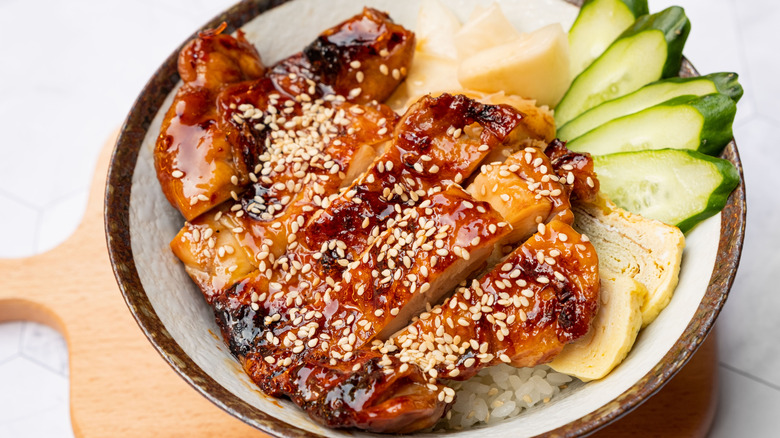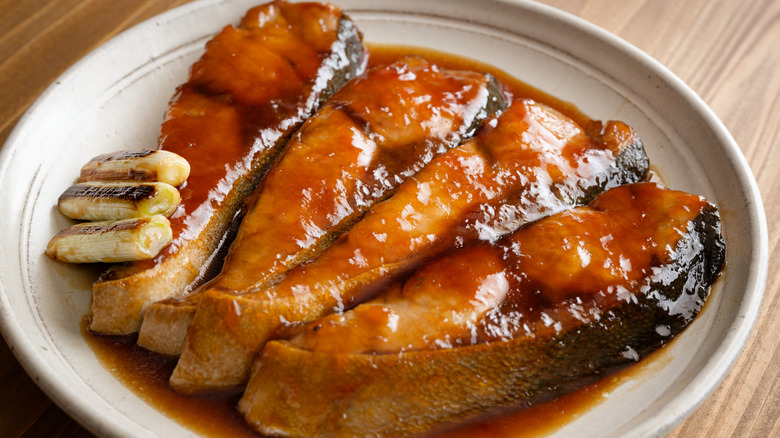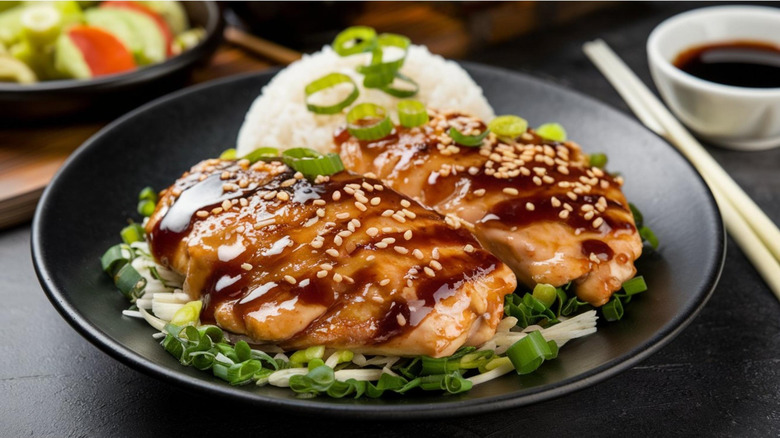How Teriyaki Became One Of Seattle's Signature Dishes
We may receive a commission on purchases made from links.
Detroit has its unique pizza, Atlanta has lemon pepper wet wings, and Seattle has teriyaki. What began in Japan centuries ago as a cooking style for preserving fish found its 20th-century home in Hawaii and Seattle, as Japanese and other East Asian immigrants adapted dishes for their new homes. In the case of Seattle, teriyaki-specific shops became so ubiquitous and identified with the city that The New York Times took note in 2010, though the number of Seattle shops has declined in recent years. These days, most towns have teriyaki joints; but, like, just a handful.
Though teriyaki was found on menus in America at least by the 1960s, the first stand-alone teriyaki shop in the country is generally believed to have opened in Seattle in 1976. It was then that Toshihiro Kasahara either created or adapted a sweeter sauce to pour over cooked chicken or beef at Toshi's Teriyaki Grill, offering a distinctive presentation at a low price. The concept was quickly embraced, and copied around the city and the country. Even national chains owe a debt to Kasahara: Denver-based Teriyaki Madness, with 160 locations and growing, specifically mentions Seattle's influence on the company's About page.
The evolution of teriyaki in America
Teriyaki got its start in Japan, possibly as much as 300 years ago. It describes a style of cooking: "teri" means luster or shine, while "yaki" means grill. It originated primarily as a way to prepare and preserve fish. A thin basting sauce of soy sauce, sake, and mirin was applied in layers during grilling, creating the namesake glaze or dipping sauce. In modern Japan, teriyaki is largely considered a make-at-home dish, with each household boasting its own signature sauce. Some teriyaki sauces are just two ingredients. It's not something most Japanese eat when dining out.
In the mid-20th century, Japanese immigrants in Hawaii adapted cooking techniques to available ingredients and local palates (hence the popularity of Spam musubi). On the islands, brown sugar, pineapple, and fresh ginger were added to the glaze, making the sauce sweeter and distinctly American. Meanwhile, the popularity of Benihana teppanyaki restaurants in the 1960s and '70s was introducing non-Japanese America to a wide variety of Japanese inspired dishes, including teriyaki. But you weren't going to find a teriyaki burger on the Red Robin menu just yet.
How teriyaki became famous in Seattle
In 1976, Japanese immigrant Toshihiro Kasahara decided to open Toshi's Teriyaki in Seattle's Queen Anne neighborhood, dedicated to serving teriyaki. In addition to popularizing a now-iconic thick sauce, Kasahara marinated chicken and beef overnight, grilled pieces on skewers, then sauced and served them alongside rice and a salad. It didn't take long for Kasahara's vision of teriyaki to influence menus across the country.
By the 1990s, there were reportedly hundreds of teriyaki shops around Western Washington. The Times counted 83 with "Teriyaki" in their name in the Seattle area in the 2010 story, many owned and operated by Korean immigrants who took up the baton in the 1980s. And while there are other versions of teriyaki-style dishes, it's probable you've grabbed a teriyaki chicken lunch inspired by Toshi's Teriyaki at least once — no matter where you live.
Modern teriyaki may have an even earlier Seattle connection. Somewhere between 1968 and 1973, Kyoto immigrant Junki Yoshida apparently used his mother's teriyaki recipe on food samples he gave away at Seattle area grocery stores. By 1982, he introduced his own Mr. Yoshida's Gourmet Cooking Sauce, and went on to become a successful businessman and television personality in Portland, Oregon.


